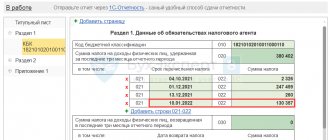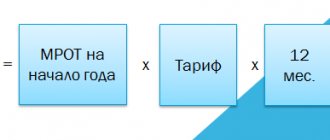Environmental tax: who should pay, when and how much?
The Ministry of Finance has published draft amendments to the Tax Code of the Russian Federation, according to which companies will begin to pay environmental tax. “Calculation” spoke with Victoria Popova, project manager for management accounting of the consulting, examination and audit department of KSK Group, and found out what exactly the department offers, how companies will calculate the new tax and who is entrusted with administering it.
The issue of non-tax payments, their quantity, and the quality of administration has been discussed in the country for a long time. In the end, the authorities decided to convert part of these payments into tax payments. The purpose of the changes is, among other things, to transfer the functions of collecting payments to the Federal Tax Service and, as a result, increase tax collection. “An analysis of the dynamics of receipts of fees for negative environmental impacts into the budget system indicates the low efficiency of its collection, which creates the need to finance state environmental programs from other revenues of the federal and regional budgets,” says the explanatory note to the bill.
Tell us in more detail what kind of project to introduce an environmental tax you are talking about.
The Ministry of Finance is considering amendments to the Tax Code regarding the creation of a new tax - environmental. The project is being prepared on behalf of Russian Prime Minister Dmitry Medvedev dated March 16, 2022 No. DM-P13-10. The Financial Department proposes to introduce a new chapter in parts 1 and 2 of the Tax Code. Public discussion of the project ended on August 31, 2022.
In essence, the new tax is the implementation of the authorities’ plan to transfer part of non-tax payments to tax payments. This is true?
Absolutely right. It is planned to replace the fee for negative environmental impact (NEI). As part of the systematization of non-tax payments, the Ministry of Finance streamlines payments that do not have signs of tax. The environmental fee currently being paid should gradually “transform” into an environmental tax from 2022. The Ministry of Finance wants to streamline non-tax payments and tighten measures for their non-payment. The environmental tax does not provide for an increase in the tax burden.
Will the fee rates change or remain the same?
Objects of taxation, payment rates, payment procedures and terms will remain the same. But the payment regime will be tightened. Officials say that for conscientious payers the fiscal burden will not change. Entrepreneurs will calculate the base themselves for each taxable object, and the rates will be calculated by type of pollutant and hazard class of production and consumption waste.
Tax rates are divided into groups:
— for emissions of pollutants into the air from stationary sources;
— for discharges of pollutants into water bodies;
— for the placement of production and consumption waste according to their hazard class.
The rate will be calculated based on 1 ton of pollutants (production and consumption waste).
note
Objects of taxation, payment rates, payment procedures and terms will remain the same. But the payment regime will be tightened. Officials say that for conscientious payers the fiscal burden will not change. Entrepreneurs will calculate the base themselves for each taxable object, and the rates will be calculated by type of pollutant and hazard class of production and consumption waste.
From 2022, the authorities will introduce coefficients to encourage emissions reduction. The highest coefficient of 100 will be applied for exceeding the established volumes or mass of harmful emissions. Conversely, the tax amount can be reduced if there were expenses associated with the implementation of measures to reduce the negative impact on the environment.
Will the number of companies required to pay environmental taxes increase or decrease?
Tax payers remain organizations and individuals, individual entrepreneurs whose activities have a negative impact on the environment.
It is difficult to estimate the change in the number of companies required to pay this tax. The complexity of the assessment is related to the development of the market and the emergence of new technologies by 2022. Currently, manufacturers and importers of goods that need to be disposed of after losing their consumer properties are required to pay the fee. Manufacturers and importers who independently ensure waste disposal are exempt from paying the fee. Of course, we would like to reduce the number of companies that will pay environmental taxes. After all, no amount of money will ensure the preservation of good ecology in the country.
Will the payee change?
Will change. Now the NVOS is paid to Rosprirodnadzor. The payment is transferred according to the details of the relevant territorial body of Rosprirodnadzor, at the location of which a stationary source of emissions (discharges) is located, a mobile object of negative impact is registered, or a waste disposal facility is located. In the future, environmental tax payers will need to register with the Federal Tax Service and pay the fee there. In this case, not only the recipient’s details will change, but also the payment BCC.
Will the tax payment procedure change?
The fee for negative impact on the environment and the environmental tax are the same. The new law does not provide for changes. The reporting period for payment of the negative impact fee and environmental tax remains the calendar year. Quarterly advance payments will also be paid; The total amount of the fee must be transferred to the budget at the end of the year. Quarterly advance payments are made by all payers (except for small and medium-sized businesses). Deadline – no later than the 20th day of the month following the reporting quarter. The advance payment for each quarter is equal to 1/4 of the payment amount for the previous year. The amount of the surcharge at the end of the year can be determined as the difference between the amount of fees accrued for the year and the amount of advance payments transferred to the budget during the year.
Environmental taxes in Russia: prospects for introduction
Environmental tax in the Russian Federation is not currently a legal category. This concept is not enshrined in any sources of law. Some experts expect that this tax will be in addition to the transport tax established by Sec. 28 Tax Code of the Russian Federation. Thus, at the Government level, initiatives are being considered to introduce standards that would allow the state to levy a fee on car owners based on the environmental characteristics of vehicles.
The environmental tax, therefore, is supposed to be levied in correlation with the intensity of environmental pollution by a particular vehicle. Probably, first of all, it will be aimed at owners of cars of outdated models, which, according to officials, will help stimulate the purchase of new brands of cars by Russians, including domestic ones. This will have a positive impact on the automotive retail market and the situation at Russian car factories.
The assessment of the government initiative to introduce an environmental tax is ambiguous. On the one hand, experts believe that the corresponding fee could indeed become an additional driver for the growth of the automotive industry and vehicle sales in the Russian Federation.
On the other hand, such an initiative is assessed as not entirely correct due to the fact that many Russian motorists, while owning a car, may not actually use it. It is not uncommon for older, non-eco-friendly cars to sit in a garage as a secondary means of transportation while their owners drive newer cars. Accordingly, such machines do not cause significant harm to the environment, but, based on the logic of the proposed initiative, a person will have to pay a tax for them.
Payment for harmful effects on the environment
An environmental tax in Russia is also informally called a fee for negative environmental impact (NVOS). Unlike the environmental fee, which was introduced only in 2014, the fee for the NVOS has existed for a long time. It was established by the Law “On Environmental Protection” dated January 10, 2002 No. 7.
The payment in question is, like an environmental fee, not a tax. Its status sounds like a “public legal payment” (definition of the Constitutional Court of the Russian Federation dated December 10, 2002 No. 284-O), which can be classified as a fiscal fee. In this case - fees of a compensatory nature (for harmful effects on the environment).
Organizations and individuals, both Russian and foreign, that work in the Russian Federation in the field of environmental management, as well as those companies that use leased equipment that has a harmful impact on the environment, must pay the fee for the environmental assessment.
Enterprises calculate this fee independently in accordance with the provisions of the resolutions of the Government of the Russian Federation:
- dated August 28, 1992 No. 632;
- dated June 12, 2003 No. 344.
Relevant payments must be made by the 20th day of the month following the reporting quarter.
The relevant payment obligations are administered by the Department of the Federal Service for Natural Resources Management.
So, neither the environmental fee nor the fee for harmful effects on the environment in the Russian Federation at this stage are taxes. Therefore, the concept of environmental tax is not yet enshrined in the legislation of the Russian Federation.
Environmental tax in Belarus
At the same time, de jure this term is present in another EAEU country - Belarus, and therefore for us, Russians, awaiting the introduction of an environmental tax in the Russian Federation, it will be useful to study the experience of the neighboring state in terms of the legal norms governing its calculation and payment.
Read about the composition of the EAEU and the responsibilities of its members in the article “Customs Union of the Eurasian Economic Union (nuances).”
The environmental tax in Belarus fully meets the criteria of a full-fledged tax. The provisions governing its calculation and payment are fixed at the level of national legislation, namely in the Tax Code of the Republic of Belarus.
Thus, payers of the corresponding tax established in Belarus are organizations and individual entrepreneurs. Also subject to payment of this tax include owners of industrial waste who practice the disposal of such substances.
The following are recognized as objects of taxation:
- emissions of substances into the atmosphere;
- water discharge;
- storage and burial of substances related to production waste;
- import into the Republic of Belarus of substances that destroy the ozone layer, both in pure form and as part of any product.
The environmental tax base in Belarus is formed by the fixed volumes:
- emissions of substances into the atmosphere;
- Wastewater;
- substances classified as industrial waste and subject to storage or burial;
- substances that destroy the ozone layer (present in pure form or as part of products).
What is taken into account when determining the tax base
When determining the tax base, the volume or weight is taken into account:
- Emissions and discharges of pollutants produced within the limits of standards.
- Emissions and discharges of pollutants produced within limits.
- Emissions and discharges of pollutants exceeding standards 1 and 2 points.
In addition, when determining the tax base, limits on the disposal of production and consumption waste, as well as their excess, are also taken into account.
Important! If the tax base is determined for tax objects for which different tax rates are established, then the tax base is determined for each of them.
What taxes can be classified as environmental?
Taking into account the previously discussed concept of environmental tax, let us look at the list of taxes, the payment of which arises in connection with the use of natural objects:
- Fee for the use of fauna and aquatic biological resources - the need to calculate this tax represents compensation for damage caused to nature as a result of hunting and catching animals or aquatic inhabitants (for example, fish or crayfish), reducing their numbers.
- Water tax - is paid for water intake and use of water bodies, which also creates an imbalance in the environmental situation due to limited water resources.
- Mineral extraction tax - is paid for the extraction of natural resources, such as oil and coal, which are exhaustible.
- Transport tax is calculated for the use of vehicles that harm the environment.
What is planned to be improved in the transport tax in order to increase its environmental component is described in detail here .
- Land tax - is paid for the use of land on which various buildings are located that harm surface soils.
Each of the above taxes reflects a fee for the impact of a person or organization on the environment, which causes environmental harm to nature, and can indirectly be considered an environmental tax.
The rates and deadlines for payment of each of the listed taxes for 2018 are shown in the table:
| Environmental tax 2017–2018 | Tax rate | Payment deadline |
| Fee for the use of fauna and aquatic biological resources | In Art. 333.3 of the Tax Code of the Russian Federation specifies a list of rates in rubles for 1 animal or for 1 ton of biological resource | Art. 333.5 Tax Code of the Russian Federation:
|
| Water tax | Art. 333.12 of the Tax Code of the Russian Federation reflects a large list of rates in rubles per 1000 cubic meters. m of water | Art. 333.12 Tax Code of the Russian Federation:
|
| Mineral extraction tax (MET) | Art. 342 of the Tax Code of the Russian Federation, interest rate in rubles or per 1 ton, or per 1000 cubic meters. m of extracted minerals | Art. 344 Tax Code of the Russian Federation:
Find out how to pay the mineral extraction tax in 2022 here |
| Transport tax | Art. 361 of the Tax Code of the Russian Federation indicates rates in rubles for each horsepower, the values of which vary depending on the number of horsepower. With. At the same time, regional authorities can increase or decrease rates as much as possible by 10 times. | Art. 363 Tax Code of the Russian Federation:
|
| Land tax | Art. 394 of the Tax Code of the Russian Federation defines 2 rate limits: up to 0.3% and up to 1.5% - depending on the category of land. | Art. 397 Tax Code of the Russian Federation:
|
How to pay the environmental fee
Environmental fee is a concept introduced by Art. 24.5 of the Law “On Production and Consumption Waste” dated June 24, 1998 No. 89-FZ. The obligation to pay such an environmental tax is assigned to the following persons when disposing of products that have lost their consumer properties:
- manufacturers;
- importers.
In this case, the specified payment starting from 2022 (i.e. from the payment for 2016) is made once until April 15 of the year following the reporting year (subparagraph “a”, paragraph 2 of the Decree of the Government of the Russian Federation dated October 8, 2015 No. 1073).
Control over the payment of the fee is entrusted to Rosprirodnadzor, and the amounts go to the federal budget of the Russian Federation.
How to determine the value of the environmental tax rate is discussed in the article “The procedure for calculating and paying environmental tax .
The calculation of this type of environmental tax is made taking into account deviations of the actual value from the standards established by the Government of the Russian Federation.
Reporting on the environmental fee, like the payment, is annual and is submitted to Rosprirodnadzor within the time limit established for payment of the fee (subparagraph “b”, paragraph 2 of the Decree of the Government of the Russian Federation dated October 8, 2015 No. 1073).
The form to use for the 2022 report can be seen here .
For an example of filling out an environmental fee declaration, see this publication.






